In World Geography, environmental issues like desertification, deforestation, climate change, global warming, and ozone depletion are critical challenges altering Earth’s landscapes and ecosystems. These interconnected problems, driven by human activities and natural processes, have profound global impacts, necessitating urgent study and action.
Desertification
Definition – Desertification is the process in which land in arid, semi-arid and dry sub-moist regions loses its productivity, water holding capacity and vegetation cover due to various natural and anthropogenic factors, thereby turning into a barren or desert-like state. This process is accelerated by climate change, overgrazing, deforestation, illegal mining and improper agricultural practices.
Desertification a global problem
- Desertification is a historical phenomenon. The world’s largest deserts have been formed over long periods due to interactions of natural processes.
- Most of these deserts have expanded or contracted over time, largely independent of human activities during those periods.
- In the central highland plateau of Madagascar, slash-and-burn agriculture practices by indigenous peoples have caused desertification of up to 10% of the country.
- Palaeodeserts are vast sand seas that have become inactive due to vegetation cover. Some original deserts, like the Sahara, are expanding beyond their current boundaries.
- In Western Asia, several deserts were formed during the Late Cretaceous period due to the high population of prehistoric tribes and sub-tribes. Sahel is another example of desertification.
- The primary causes of desertification in the Sahel include slash-and-burn agriculture, where wind removes unprotected topsoil, leading to soil erosion.
- Central Asian countries such as Kazakhstan, Kyrgyzstan, Mongolia, Tajikistan, Turkmenistan, and Uzbekistan are also affected by desertification. In Kazakhstan, more than half of the arable land has been abandoned since the 1980s.
Major causes of desertification
- Industrial waste – Waste from textile, dyeing and printing industries in Jodhpur, Pali and Balotra towns are discharged into rivers polluting surface and groundwater.
- Wind erosion – Sand dunes and other formations in the Thar Desert are affected by wind erosion. Deep plowing using tractors, farming on sandy slopes, leaving land fallow for long periods, and traditional agricultural practices accelerate the spread of sand and desertification.
- Environmental concerns take a backseat due to population growth and economic pressures.
- Waterlogging in the ground and increasing salinity and alkalinity – Salinity and alkalinity issues have emerged in alluvial plains due to irrigation using saline groundwater. In Kutch and Saurashtra, seawater intrusion has contaminated freshwater sources. In the Indira Gandhi Canal region, waterlogging and increasing salinity-alkalinity have become serious concerns.
- Deforestation – Growing population pressure on land has led to deforestation and shrinking forests, further promoting desertification.
- Soil Erosion by Water – Large areas in the upper regions of Saurashtra and Kutch are affected by water erosion. Erosion alters land surfaces and accelerates soil degradation.
Control measures
- Sand Dune Stabilization: To stabilize the sand dunes of Rajasthan, CAZRI (Central Arid Zone Research Institute) has adopted bio-intervention techniques and wind barrier methods from the dune base to the top. Tree and grass species such as Israeli Babool (Acacia tortilis), Phog (Calligonum polygonoides), Sewan (Lasiurus sindicus), Mopane, and Ghaman (Cenchrus ciliaris) are suitable. Intercropping of trees, crops, and grasses can be done on sand dunes to enhance stability.
- Shelterbelt Plantation: To prevent soil erosion due to strong winds, trees are planted in 3-5 rows in the direction of the wind. This reduces soil degradation and protects agricultural land.
- Aerial Seeding: In sandy and difficult terrains, traditional afforestation is challenging due to moisture deficiency and uncertain rainfall. Aerial seeding (dropping seed balls from aircraft) is used. Seed germination rates of 70-80% are achievable when seeds are mixed with soil and manure.
- Silvopasture System: To meet the fuelwood and fodder demand, a combined cultivation of trees, plants, and grasses is practiced. This method prevents soil erosion and increases land productivity. If Acacia tortilis trees can provide 60 quintals per hectare of fuelwood and Cenchrus ciliaris grass can provide 46 quintals per hectare of fodder, then together they can yield 50 quintals per hectare of fuelwood and 55.8 quintals per hectare of fodder.
- Efficient Use of Irrigation Water: Sprinkler irrigation systems are highly effective in arid regions to conserve water and grow grasses. This method has saved water and significantly increased the yield of Lasiurus sindicus grass in western Rajasthan. However, excessive water usage may lead to an increase in groundwater levels.
- Regulation of Mining Activities: Abandoned mining lands can be re-greened by planting species like Prosopis juliflora and Acacia tortilis to restore vegetation and prevent further desertification.
United Nations Convention to Combat Desertification (UNCCD)
- The UNCCD is one of the three Rio Conventions under the United Nations.
- It is the only legally binding international agreement that addresses both environmental and developmental issues.
- June 17 is observed annually as “World Day to Combat Desertification and Drought” to raise awareness about global efforts to combat desertification.
The Bonn Challenge
- The Bonn Challenge is a global initiative aimed at restoring degraded forests and improving ecological balance.
- It was launched in 2011 in Bonn, Germany.
- Goals of the Bonn Challenge:
- Restore 150 million hectares of degraded and deforested land by 2020.
- Restore 350 million hectares by 2030.
- At the Paris Climate Summit in 2015, India voluntarily committed to the Bonn Challenge.
- Initially, in 2015, India set restoration targets under two phases:
- 13 million hectares by 2020.
- 8 million hectares by 2030.
- Later, India increased its target to restore a total of 26 million hectares by 2030.
India’s efforts
- To prevent desertification, the Government of India has launched several programs and schemes, including afforestation efforts.
- Key initiatives include:
- Green India Mission (GIM)
- Nagar Van Yojana (Urban Forest Scheme)
- Compensatory Afforestation Fund Management and Planning Authority (CAMPA)
- Mahatma Gandhi National Rural Employment Guarantee Scheme (MGNREGS), which focuses on land restoration.
- India has also launched a National Action Plan to combat desertification and forest degradation through afforestation efforts.
- However, despite these efforts, India faces a major challenge, as 32% of land has undergone soil degradation, and 25% of land has been affected by desertification.
Land degradation and desertification in India
- 97.85 million hectares of India (29.77% of the total geographical area of the country) faced land degradation during 2018-19.
- During the period 2011-13 and 2003-05, 96.40 million hectares (29.32%) and 94.53 million hectares (28.76%) of land was degraded respectively.
- Total increase in land degraded area between 2011-13 to 2018-19 – 1.45 million hectares (0.44% of total geographical area).
- Causes of land degradation/desertification in India –
- Water erosion [11.01%]
- Vegetation loss [9.15%]
- Wind erosion [5.46%]
- Land degradation in dry regions (arid, semi-arid and dry-sub-humid) is called desertification.
- A total of 83.69 million hectares of area was affected by desertification in 2018-19.
- Increase in desertified area between 2011-13 and 2018-19 – 1.05 million hectares.
- Wind erosion is the main cause of desertification in dry areas.
- Water erosion and vegetation loss are the main causes in semi-arid and dry-sub-humid areas.
- About 23.79% of the area affected by desertification/land degradation in relation to the total geographical area of the country was from Rajasthan, Maharashtra, Gujarat, Karnataka, Ladakh, Jharkhand, Odisha, Madhya Pradesh and Telangana.
- In terms of their total geographical area (TGA), Jharkhand, Rajasthan, Delhi, Gujarat and Goa have more than 50% of their area facing desertification/land degradation.
In the context of Rajasthan
- In Rajasthan, 62.06% (21.23 m.ha) of the total geographical area of the state was facing desertification/land degradation in 2018-19.
- During the period 2011-13 and 2003-05, this area was 62.90% and 63.19% respectively.
- A reduction of 0.84% was observed in desertification/land degradation between 2011-13 and 2018-19.
- The main cause of desertification/land degradation in the state
- Wind erosion [43.37%]
- Vegetation loss [7.64%]
- Water erosion [6.21%].
- Between 2011-13 and 2018-19, there was a decrease in the area affected by wind erosion/deposition and an increase in the area affected by human activities. Whereas, between 2003-05 and 2011-13, there was a decrease in the area affected by wind erosion/deposition and an increase in the forest area affected by vegetation loss.
Deforestation
- Forests are areas covered with trees and plants that absorb carbon dioxide and emit oxygen, keep the atmosphere balanced and indirectly help in preventing global warming.
- According to scientists, before human development, 25% of the earth was covered with forests, and they are a major example of geo-ecology.
- Forests are not only a source of fuel and raw materials, but also maintain atmospheric humidity, increase rainfall, control river flow and pollution, prevent soil erosion and floods. They are helpful in maintaining water cycle, air cycle and land fertility.
- Forests are the shelter of many animals and birds, a source of medicines, and can be developed as a source of recreation and income. They provide raw material for cottage industries such as cane, honey, gum, lac etc.
- Forests prevent noise and air pollution and are the lifeline of any nation. Environmental stability and ecological balance depend on the condition of forests.
Deforestation
- Due to current economic activities, natural vegetation is facing serious environmental and ecological problems, such as soil erosion, frequency and extent of floods, drought due to reduction in rainfall, and extinction of many animal species.
- For ecological balance, one-third of the total area of every country should be covered with dense forests, but this rule has been neglected in most countries.
Causes of Deforestation
- Industrialisation: Forests are cut down to make land available for industrial development. Forests are extensively used for raw materials and fuel for industries, mining and packaging.
- Shifting cultivation: In tropical regions, burning of forests for shifting cultivation increases the fertility of the land, but it causes rapid erosion of the land.
- Overgrazing: Excessive grazing by animals prevents the growth of new vegetation, which leads to the destruction of forests.
- Conversion of Grasslands: In marine climatic regions worldwide, particularly in temperate and subtropical zones of North and South America and Africa, forests have been extensively converted into grazing lands for dairy farming.
- Conversion of Agricultural Land: The need for agricultural land to support the growing population has led to rapid deforestation. Many developing countries in tropical and subtropical regions are particularly affected.
- Forest fire: Forest fires caused by natural (lightning strikes) and anthropogenic causes cause rapid destruction.
- Poverty: Poor communities depend on forests for their livelihoods, leading to increased deforestation. In developing countries like India, a significant portion of the population relies on forests for firewood and minor forest produce.
- Multi-purpose projects: Dams and reservoirs require large-scale submergence of forests, leading to permanent loss of forest cover.
Adverse Effects of Deforestation
- Environmental damage: Deforestation disrupts the natural balance, leading to problems such as land erosion, floods, drought, low rainfall and environmental pollution.
- Water crisis: Absence of forests leads to reduced rainfall, which causes water sources such as ponds, wells and streams to dry up.
- Soil erosion: In the absence of forests, rainwater damages the soil, while the roots of trees strengthen the soil.
- Landslides: Deforestation increases the incidence of landslides, causing huge loss of life and property.
- In the absence of forests, flood control is disrupted, leading to the destruction of crops, lives, and fertile soil.
- As a result, land productivity decreases, and the availability of arable land declines.
Measures to prevent deforestation
A. Proper Forest Management Policy
- To control deforestation, a scientific and systematic approach should be adopted:
- Tree felling should be done rationally and scientifically
- Special efforts should be made to protect forests from environmental threats such as soil erosion, plant diseases, and deforestation.
- Afforestation should be promoted, considering regional requirements and conditions.
- Plantations should not replace natural forests. In Himachal Pradesh, cutting down forests for apple orchards has harmed the local environment.
B. Forest Conservation
- The government should take control of forest areas and impose strict restrictions on deforestation.
- In India, sensitive forest species have been legally protected under government initiatives.
C. Social Forestry
- Social forestry is a forest development system that considers economic and social needs of communities while promoting afforestation and regulated tree-cutting for fuelwood.
- Under this system, trees are planted on: Barren land, village common land, along canals, roads, railway tracks, and degraded forest areas.
- Benefits of Social Forestry:
- Utilization of barren land.
- Employment generation to reduce unemployment.
- Development of recreational spaces.
- Boost to cottage industries.
- Reduction of environmental pollution.
- Employment for rural artisans.
- Increased income for the poor.
- Development of transport routes.
D. Public Participation in Forest Conservation
- Public awareness is essential for forest conservation. Without people’s involvement, deforestation cannot be stopped.
- People should be made aware of the consequences of deforestation. Notable movements include: Chipko Movement (Uttarakhand), Soil Conservation Campaign (Hoshangabad). Women-led pledge to stop logging (Shyampur).
- Other Environmental Movements: Women’s movement in Reni village (Uttarakhand), Protests against Amazon rainforest deforestation, Environmental slogans like “Save the Sick Himalayas.”
- Van Mahotsav (Forest Festival) – 1952: Initiated by the Government of India in July 1952 under the National Forest Policy. Based on the concept: “Trees mean water, water means food, and food is life.”
Government Measures for Environmental Protection in India
1. Establishment of the Environmental Protection Department In 1980, the Government of India established the Environmental Protection Department.
- State governments were also instructed to set up their own environmental departments.
- Responsibilities: Formulating and implementing environmental protection policies.
Comprehensive Environmental Protection Act, 1986
- A landmark act was enacted in 1986 to address previous shortcomings in environmental regulations.
- The act empowers central and state authorities to take necessary measures for environmental protection.
- 20 state governments were given authority to issue guidelines for the implementation of this act.
Biodiversity Act-2002
- Regulates access to the country’s biological resources to ensure equitable sharing of benefits arising from their use.
- Aims to govern the use of biological knowledge related to these resources.
- A National Biodiversity Conservation Plan has been developed to coordinate agencies dealing with biodiversity conservation.
- National Biodiversity Authority (NBA) was established in Chennai for effective implementation.
Central pollution control board
- An autonomous body under the Ministry of Environment and Forests (MoEF).
- Established in September 1974 under The Water (Prevention and Control of Pollution) Act, 1974.
- Coordinates State Pollution Control Boards (SPCBs) and Pollution Control Committees (PCCs).
- Advises the central government on pollution prevention and control
National Afforestation and Eco-Development Board
- Established in 1992.
- Responsible for afforestation, maintaining ecological balance, and promoting eco-development activities in the country.
National Air Quality Monitoring Programme
- Under the National Air Quality Monitoring Programme (NAMP), the four air pollutants regularly monitored are Sulphur Dioxide (SO2), Oxides of Nitrogen (NO2), Respirable Suspended Particulate Matter (RSPM/PM10), and Fine Particulate Matter (PM2.5)
- Monitors toxic substances such as lead and polycyclic aromatic hydrocarbons (PAHs) in seven major metropolitan cities.
Environmental Protection Policies
- National Forest Policy (1986)
- Pollution Prevention Framework (1991)
- Forest Conservation Act (1980, 1988)
- Water Prevention and Pollution Control Act (1977, 1988)
- Air Prevention and Pollution Control Act (1981, 1987)
- National Wildlife Action Plan.
National River Conservation Directorate
- Phase-I of the Ganga Action Plan (GAP) started in 1985 but was discontinued on March 31, 2000.
- The National River Conservation Authority (NRCA) reviewed the progress of the Ganga Action Plan and other river-cleaning programs.
- Phase-II of the Ganga Action Plan was merged with the National River Conservation Plan (NRCP).
Problems related to atmospheric environment
Atmospheric Environmental Issues – Excessive use of fossil fuels (coal, petrol, diesel, gas), rapid deforestation, and increased transportation activities have led to global climate change.
Major Atmospheric Imbalances:
- Ozone Depletion (Ozone Hole)
- Global Warming
- Acid Rain
- Greenhouse Effect
These environmental challenges demand urgent intervention through policy reforms, sustainable practices, and international cooperation.
Greenhouse Effect, Global warming and Climate Change
Greenhouse Effect
- A natural process that keeps the Earth’s atmosphere warm and makes it suitable for life.
- This effect occurs when the energy coming from the Sun (solar radiation) reaches the Earth’s surface, where it is absorbed and then re-emitted as infrared radiation. This infrared radiation is then emitted back into space.
- The greenhouse gases present in the atmosphere absorb this infrared radiation and re-emit it toward the Earth’s surface and lower atmosphere.
- The Earth maintains a certain temperature range, allowing life to exist [ Natural Greenhouse Effect]. However, due to human activities, the Earth’s temperature is continuously increasing [Human-Induced Greenhouse Effect].
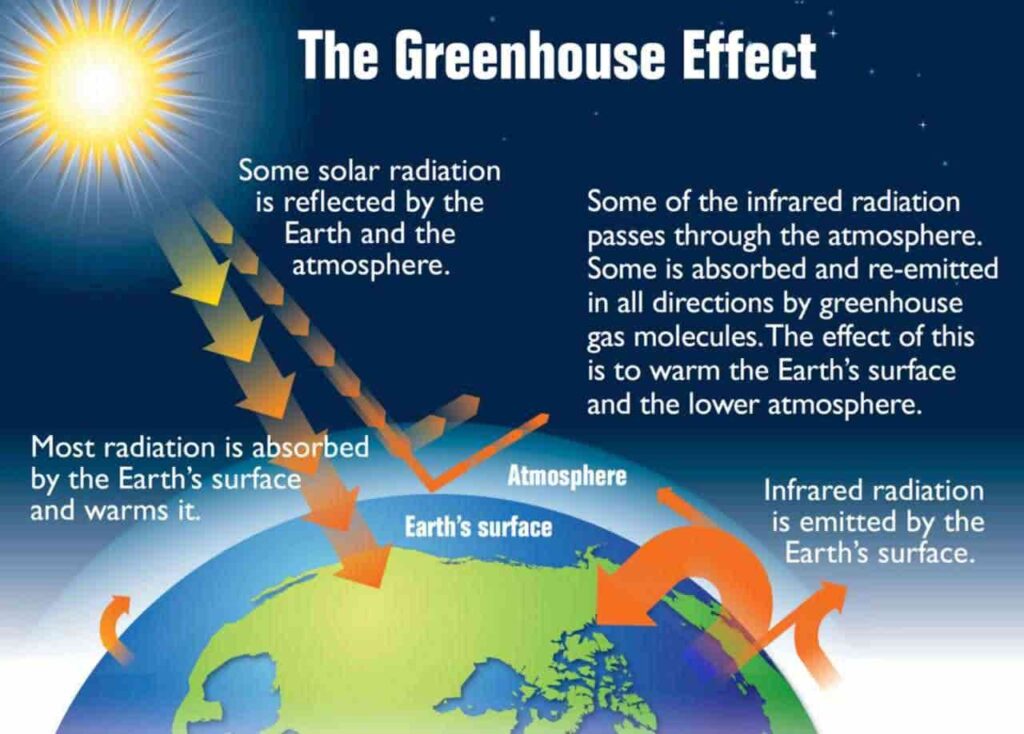
Global warming definition –
- This is the long-term increase in the average temperature of the Earth’s atmosphere and surface, primarily caused by the rising emissions of greenhouse gases due to human activities.
- The term Global Warming was first used by scientist Wallace Broecker in 1975.
- It refers to the balance between the thermal energy reaching the Earth and the thermal energy reflected back into space.
- Before the Industrial Revolution (1850-1900), the global average temperature was approximately 13.7°C. By 2024, this average temperature has increased to about 14.8°C, indicating a rise of 1.1°C.
- According to the IPCC report, the temperature is increasing by an average of 0.2°C every decade.
- Note – Global Cooling
- It is the opposite of global warming. In the 1970s, scientist Gerald Stanhill referred to the continuous decline in temperature after 1950 as Global Cooling. However, this concept is not true because the Earth’s temperature is actually increasing.
| GHG – Carbon dioxide (CO₂), Methane (CH4), Nitrous oxide (N₂O), Water vapour, Ozone (O3), F-gases [Chloro-fluoro-carbons (CFCs), Hydrofluorocarbons (HFCs), Perfluorocarbons (PFCs), Sulphur hexafluoride (SF6), Nitrogen trifluoride]. The effect of greenhouse gases depends on their quantity, concentration, lifespan, and Global Warming Potential (GWP), where CO₂ serves as the baseline with a GWP of 1. GWP (Global Warming Potential) – It indicates the ability of greenhouse gases to trap heat in the atmosphere compared to CO₂. The GWP is typically calculated over a 100-year timeframe. CO₂ – It is the standard reference gas,so its GWP is 1. | |||
| GHG | Contribution | Sources | Mitigation |
| CO₂ | 75% of anthropogenic (human-induced) GHG emissionsPrimary GHG(GWP): 1Lifetime: 50 – 200 years | Natural Sources: Respiration, combustion process, volcanic eruptions; Human Activities: Deforestation, industrialization, fossil fuel burning | Energy conservationCarbon sinks (Forests/Oceans), renewable energy |
| Before industrialization, the concentration of CO₂ was around 280 parts per million (ppm), around the 1950s and 1960s, it was around 330 ppm. In June 2024, it reached 426.91 ppm. | |||
| CH₄ | About 16%GWP: 29.8, Lifespan: 12 years. | Wetlands, paddy crops, ruminant animals, termites, coal mines, gas drilling, and the ocean. | Natural processes, chemical reactions |
| N₂O | About 6%GWP: 273, Lifespan: 120 years. | Fertilizer industry, fossil fuel combustion, leather industry, industrial activities, seawater, volcanic eruptions. | Absorption by bacteria, destruction by UV radiation |
| F-gases | About 2%Higher GWP, longer atmospheric lifetime. | Refrigeration, air conditioning, industrial processes. | |
| CFC – Used as a coolant (refrigerator, AC)Apart from global warming, it causes the most damage to the ozone gas. HFCS – Produced from waste materials from industrial activities.Used in refrigerants, aerosols, solvents and fire extinguishers. PFCS – Produced in aluminium-containing electronics materials or aluminium industries. SF6 – Produced from the combustion of sulfur-containing fuels.Mainly used in the electrical industry as an insulating gas, especially in high-voltage switchgear and circuit breakers.GWP is 25,184, and its lifespan is 3,200 years. Note – GWP, IPCC’s new report AR6 tells us that we don’t have to get into different sources. | |||
| Water vapour | A variable atmospheric component whose concentration decreases with altitude. It is short-lived and contributes to the greenhouse effect.Due to rising global warming, evaporation and transpiration increase, leading to a rise in the amount of water vapor in the atmosphere. | ||
| Ozone | If present in the troposphere, it absorbs solar radiation. | ||
| Carbon monoxideShort-lived greenhouse gas.Note- Black carbon – is produced mainly by burning coal, hence it is also called soot carbon.Brown carbon – is produced by burning crop residues. | |||
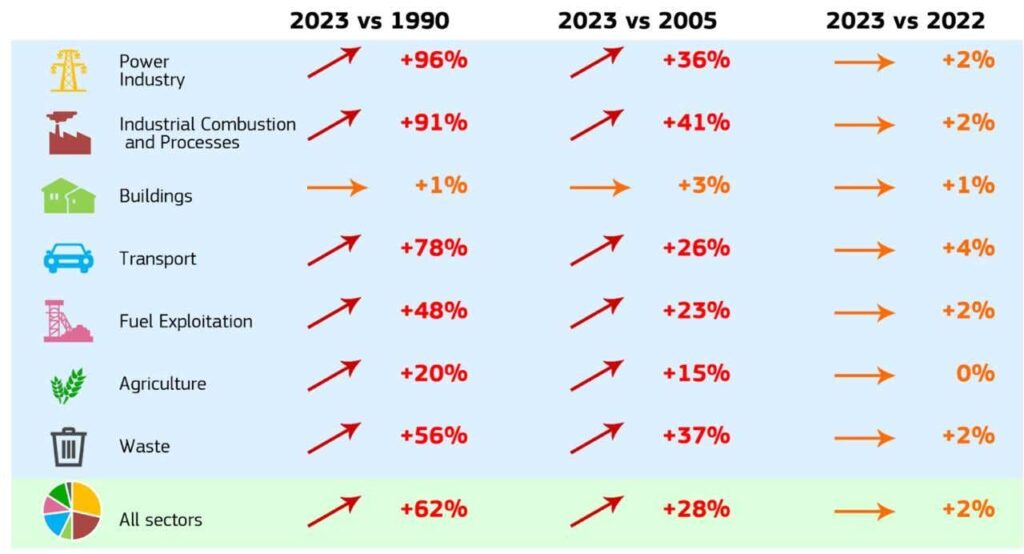
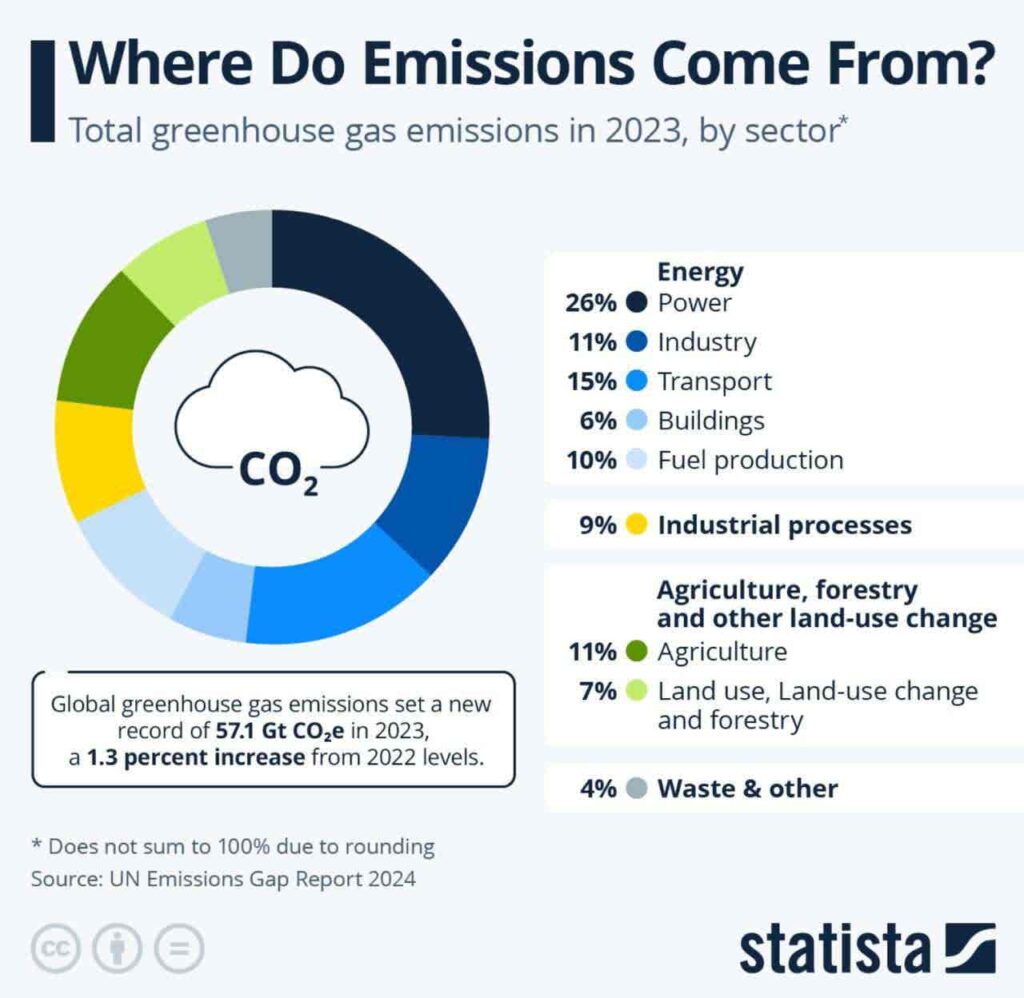
Highest contribution to global carbon emissions – (i) China [31.8 % (ii) USA [14.4 %] (iii) India [9.5 %].
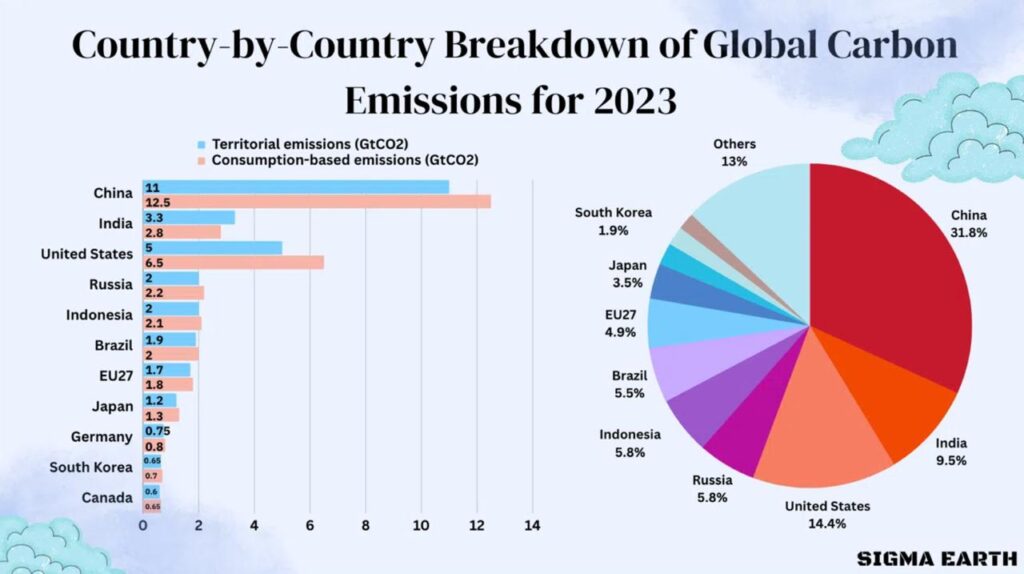
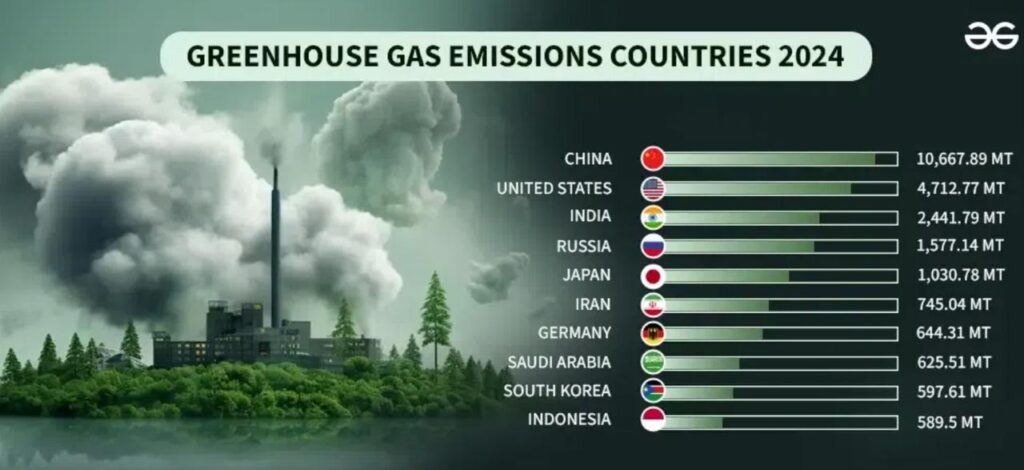
Causes of greenhouse effect
- Industrialization (due to the use of coal, petroleum in industries).
- Deforestation – Carbon dioxide is a very useful gas because it is very essential for photosynthesis in plants but due to continuous deforestation and reduction in trees, the amount of CO2 in the atmosphere is continuously increasing. It is harmful in excess.
- About 80% of CO2 is released into the atmosphere by the combustion of fossil fuels (wood and coal).
- Use of refrigerators and air conditioners – The manufacturing and use of refrigerators and air conditioners produce CFC (chlorofluorocarbon) gas which increases the amount of greenhouse gases.
Side effects
- The level of methane and nitrous oxide gases has increased significantly in the last 100 years. The concentration of CO2 has increased by 30%.
- The amount of methane in the atmosphere has increased by about 145% since the time of the Industrial Revolution.
- This has increased the greenhouse effect and increased the warming of the earth. Its main effects are as follows:
- Increase in temperature
- Increase in rainfall – The cycle of rainfall will change, rainfall will increase, but in some countries the opposite situation will lead to desertification.
- Rise in sea level – A temperature increase of just 0.5°C to 1.5°C will result in the melting of glaciers and polar ice caps, leading to flooding in coastal plains.
- Possibly, several islands will submerge, and sea levels will rise. For example, Tuvalu and the Carteret Islands in the Pacific Ocean have already submerged, and there is a risk of Maldives sinking as well.
- Changes in vegetation areas – There will be changes in the boundaries of grassland and forest areas, there may be a possibility of famine in the sandy areas of Africa.
- Increase in Disease Levels – Changes in vegetation zones may lead to variations in insect populations, increasing the risk of diseases. A 3-5°C rise in temperature could result in a 45-60% increase in malaria cases.
- Threat to biodiversity – As a result of temperature increase, 80% of biodiversity will be threatened.
Climate Change
Climate change refers to long-term changes in the Earth’s climate system, caused mainly by human activities, such as greenhouse gas emissions, but also by natural causes such as volcanic eruptions and solar activity.
Climate change can cause problems such as global warming, increase in natural disasters, loss of biodiversity and adverse effects on agriculture.
Factors affecting climate change-
(A) Natural factors (B) Human factors
A. Natural factors
- Continental drift – The continents present on the earth are mobile. Due to which there is a change in the distribution of sea currents, water and land. As a result, there is a change in the amount of humidity and rainfall, which changes the climate.
- Change in the Earth’s orbit – The Earth’s rotation is elliptical, due to which the difference in the distance between the Earth and the Sun is found to be different in a year. Change in the Earth’s orbit increases the temperature by half a degree per century. Due to which climate change is possible.
- Earth’s Axial Tilt – The Earth is tilted at 23.5° on its axis, causing warmer temperatures in the Northern Hemisphere for half the year and in the Southern Hemisphere for the other half, while the opposite hemisphere experiences colder conditions. An increase in axial tilt would lead to variations in solar radiation, contributing to climate change.
- Volcano – Volcanic eruptions release gases that form cloud cover, reducing the amount of sunlight reaching the Earth’s surface and lowering temperatures. For example, the 1991 eruption of Mount Pinatubo in the Philippines caused a 0.5°C decrease in global temperature.
- Variation in Solar Radiation – The Sun occasionally experiences magnetic storms, leading to temporary drops in solar temperature, known as sunspots. Additionally, explosions in the Sun’s outermost layer (corona) can cause solar storms, increasing solar radiation and temperature on Earth.
B. human factor – (i) Fossil fuel combustion, (ii) Industrial processes, (iii) Biomass combustion, (iv) Deforestation, (v) Land-use change
Evidence/ Proof of Climate Change
- Rise in sea level- Continuous rise in sea level.
- Increase in global warming
- Warming of sea water
- Shrinking of ice sheets or reduction in the amount of ice at the poles.
- Reduction in the number of glaciers
- Increase in sea salinity
Effects of Climate Change
(i) Due to climate change, there will be an increase in extreme heat waves, heavy rainfall, rising sea levels, ocean acidification, and forest fires. This will lead to- Threats to biodiversity,Challenges in agriculture, Increased sensitivity of human health to diseases, and Rising social and economic problems.
(ii) Effect on agriculture – While global warming and increased CO₂ levels may benefit certain crops and regions, the overall challenges outweigh the benefits. These challenges include – Nutrient depletion, Reduced soil moisture, Decreased water availability, Excessive rainfall causing floods, and Low rainfall leading to droughts.
Additionally, rising water temperatures will force fish and other aquatic organisms to migrate in search of suitable habitats.
Effects of climate change
- Increase in Temperature
- Melting of Glaciers
- Rise in Sea Levels
- Extreme Weather Conditions
- Ocean Acidification
- Changes in Rainfall Patterns
- Loss of Wildlife
- Severe Droughts and Forest Fires
- Submersion of Island Nations
- Increase in Frequency of Tropical Cyclones
- Agricultural and Food Crisis
- Threat to Biodiversity
- Increase in Pathogens and Diseases
Intergovernmental Panel on Climate Change [IPCC]
- Official panel of the United Nations
- Founded: 1988
- Founded by World Meteorological Organization + United Nations Environment Programme
- Headquarters: Geneva (Switzerland)
- The President is elected by all 193 countries through a democratic process.
- Indian-origin Rajendra Pachauri was elected as the chairman of IPCC. Pachauri prepared a report on environmental studies which is called IVth report. In 2007, this organization was awarded the Nobel Prize which was received by Rajendra Pachauri and the US President.
- Nobel Peace Prize in 2007
- 195 members
IPCC report on climate change
- Since its inception in 1988, IPCC has produced six reports
- The most comprehensive scientific report on climate change
- IPCC 1st Report on Climate Change [1990]
- Global temperature increased by 0.3 – 0.6°C over the past 100 years.
- By 2025, global temperature is expected to rise by 2°C compared to pre-industrial levels, and by 2100, it may increase by 4°C. Additionally, sea levels are projected to rise by 65 cm.
- In 1992, this report became the basis for the United Nations Framework Convention on Climate Change (UNFCCC).
- 2nd Report [1995] – Scientific basis for the Kyoto Protocol in 1997.
- 3rd Report [2001]
- 4th Report [2007] – Nobel Peace Prize 2007 for IPCC
- 5th Report [2014] – Scientific basis for the Paris Agreement in 2015.
- IPCC Sixth Report on Climate Change [2023]
- More than 45% of the global population resides in areas that are highly vulnerable to climate change.
- Multiple climate hazards will occur simultaneously, and climate and non-climate risks will interact with each other.
- Climate change is likely to increase malnutrition, hunger, and the spread of diseases.
- Global temperature has already increased by 1.1°C compared to pre-industrial levels.
- Main causes include fossil fuel consumption, energy usage, and unsustainable land exploitation.
- Despite progress in climate mitigation policies and laws, temperatures are likely to rise beyond 1.5°C by the end of the 21st century.
- To limit warming to 1.5°C, emissions must be reduced by 43% by 2030 and 60% by 2035, compared to 2019 levels.
Climate Change Solutions
Scientists have proposed geoengineering techniques to reduce global warming, but their feasibility remains uncertain.
- Volcanic Eruption Affect – Active volcanoes release sulfur dioxide into the atmosphere, increasing cloud formation. This reduces sunlight reaching the Earth’s surface, leading to lower temperatures.
- Use of Large Mirrors – Deploying large mirrors in space to reflect sunlight away from Earth, reducing heat absorption.
- Artificial Trees – Artificial trees can absorb carbon dioxide from the air and store it in deep ocean layers.
- Solar Radiation Management (SRM) – Aerosol injection: Spreading sulfur dioxide particles in the atmosphere to reflect sunlight back into space. Use of white surfaces: Increasing Earth’s reflectivity by painting surfaces white. Marine cloud brightening: Spraying sea salt into clouds to make them more reflective. Space-based solar shields to block sunlight from reaching Earth.
Recommendations made in the report
- Increasing renewable energy and phasing out fossil fuels.
- Financing is the most important and fundamental need for action in developing countries.
- Increasing private sector participation.
- Involve people most affected by climate impacts in creating solutions.
Global efforts
Stockholm Conference – 1972
- Known as the “Magna Carta of the Environment”.
- Aimed at reducing conflicts between human development and environmental conservation.
- It was the first global environmental summit, leading to the establishment of the United Nations Environment Programme (UNEP).
- Headquarters: Nairobi, Kenya
- Objective: To provide technical and financial support for environmental conservation. Decision to observe World Environment Day on June 5.
- Under this conference, India launched the “Project Tiger” initiative for tiger conservation.
United Nations Conference on Environment and Development (UNCED)
First Earth Summit
- When: 3-14 June, 1992
- Where: Rio de Janeiro, Brazil
- Participants: Representatives from 178 countries
- Main objectives – Balancing environmental protection and economic development. Integrating sustainable development into the global agenda. Addressing issues like greenhouse gas emissions, biodiversity loss, deforestation, and pollution. Promoting economic growth without harming the environment.
- In this conference, sustainable development was talked about in which a way of economic development was suggested that does not harm the environment.
- Main results
- UNFCCC: United Nations Framework Convention on Climate Change Aim: To control greenhouse gas emissions and combat climate change.
- United Nations Convention on Biological Diversity (CBD) A treaty for biodiversity conservation, sustainable use of biological resources, and equitable sharing of benefits.
- United Nations Convention to Combat Desertification (UNCCD) – Established to prevent desertification and land degradation.
- Agenda 21: A global action plan for sustainable development in the 21st century, covering local, national, and global levels.
- Forest Principles: non-binding guidelines for the conservation and sustainable management of forests.
- Commission on Sustainable Development (CSD): established to monitor the implementation of Agenda 21.
- A fund created to support climate action, biodiversity conservation, ozone layer protection, and international water pollution control.
United nations agreement on climate change (UNFCCC)
- First multilateral international agreement on climate change
- Effective since March 1994
- Legally non-binding
- Goal: Reduce GHGs emissions to combat global warming
- Action: Hold annual conference on climate change
COP-1
- In 1995, in Berlin, the capital of Germany, there was agreement on making joint efforts to tackle climate change.
Kyoto Protocol COP-3
- An international agreement linked to the UNFCCC signed in December 1997 in Kyoto, Japan. Detailed rules related to the internationally binding protocol – Marrakesh Accord.
- Effective 16 February 2005 [with signing by Canada]
- 192 countries Parties to the Kyoto Protocol [Only UNFCCC members are parties to the Kyoto Protocol]
- 84 countries Signatories to the Kyoto Protocol
- Canada, Andorra, USA, South Sudan are not parties to the Kyoto Protocol
- In this conference, it was accepted that developed countries are mainly responsible for climate change as a result of industrialization.
- First commitment – 5.2% reduction in the emission of 6 greenhouse gases from 1990 levels from 2008 to 2012.
- Second commitment – 18% reduction in the emission of 6 greenhouse gases from 1990 levels from 2013 to 2020.
- 6 GHGS: CO2, Methane, Nitrous Oxide, Hydro Fluorocarbons, Perfluorocarbons PFCs, Sulphur Hexa-fluoride
- Each country in Europe [EU-15] is targeted to reduce 8% of current greenhouse gas emissions, USA 7%, Japan 6%.
- International shipping and international aviation not included in meeting Kyoto Protocol targets.
- Countries can use land use (LU), land-use change (LUC) and forestry to meet their Kyoto targets.
- The principle of common but differentiated responsibility [CBDR] was adopted under this protocol, based on past actions by industrially developed countries.
- The meetings of the Parties to the Kyoto Protocol are called CMPs.
- Classification of member countries under the Kyoto Protocol
|
Annex-I |
Annex-II |
|
|
- To ensure that the above emission reduction does not have an adverse effect on industries, the concept of Clean Development Mechanism (CDM) was adopted.
Clean Development Mechanism
- Established under Article 12 of the Kyoto Protocol.
- Based on the concept of Carbon Credits / Carbon Market.
- Developed countries committed to emission reduction are allowed to implement emission reduction projects in developing countries.
- These projects focus on sustainable and green development, allowing developed nations to earn carbon credits by investing in such initiatives.
- Carbon credit buyers can use these credits to demonstrate their emission reductions and meet their own emission targets.
- This mechanism serves dual purposes:
- Helps developed nations fulfill their emission reduction commitments.
- Encourages sustainable development in developing countries.
Note
- New Zealand implemented carbon tax in May 2005, followed by Australia on July 1, 2012.
- A solar power plant was set up in the Mojave Desert (California, USA).
- Sweden is the only country in the world where trains are powered by biogas.
Johannesburg Conference-2002
- Held in Johannesburg, South Africa from August 26 to September 4, 2002.
- Also known as “Rio+10” Summit, as it was another Earth Summit.
- Key issue: Global warming.
- Indian Prime Minister Atal Bihari Vajpayee emphasized: Development should be sustainable, ensuring that economic progress does not harm human civilization and protects essential life-supporting systems.
CoP-11/CMP-1
- Held in Montreal, Canada, in 2005.
- With Canada’s signing, the Kyoto Protocol officially came into effect.
CoP-13/CMP-3
- In 2007, at a summit in Bali, Indonesia, the Bali Roadmap or Bali Action Plan was adopted, under which 5 commitments were agreed upon.
- Shared vision: Collaboration among stakeholders to achieve long-term emission reduction goals
- Mitigation: Increasing national and international efforts to reduce the adverse effects of climate change
- Adaptation
- Technology
- Financing
CoP-16/CMP-6
- Developed countries agreed to provide $100 billion per year to developing nations from 2012 to 2020 for climate change mitigation and adaptation.
- Establishment of the Green Climate Fund (GCF).
- Objective of GCF – To support developing and least developed countries in addressing climate change challenges.
COP 18/CMP 8
- Held in November 2012 in Doha, Qatar.
- Main Objective: To extend the Kyoto Protocol beyond its first commitment period (2008-2012) into a second phase (2013-2020) – Known as the Doha Amendment.
- First-time recognition of “Loss and Damage” due to climate change as a formal issue.
- To enhance climate-related programs in developing nations, the United Nations Green Climate Fund (GCF) was officially established on November 18, 2012.
- Headquarters: Incheon, South Korea (Songdo City).
CoP-21/CMP-11/CMA-1
- Held in 2015 in Paris, France.
- Paris Agreement – Aimed at: Limiting global temperature rise to well below 2°C above pre-industrial levels.
- Striving to keep temperature increase within 1.5°C to mitigate severe climate impacts.
- Under the agreement, all countries were expected to set their own emission reduction targets through Nationally Determined Contributions (NDCs).
- Impact of 1.5°C+ warming: Would have devastating effects on small island nations and highly vulnerable regions, leading to stronger storms, droughts, and floods.
- 55% Rule for Implementation: The agreement would be legally binding only if two conditions were met: At least 55 countries had to ratify the agreement.
- These countries had to account for at least 55% of global GHG emissions.
- The Paris Agreement formally entered into force on Nov 4, 2016.
Intended Nationally Determined Contribution (INDC)
- India pledged to reduce its emission intensity by 33-35% by 2030 compared to 2005 levels (later updated in CoP-26).
- India estimated a need for $2.5 trillion in financial support for its climate action plans by 2030.
- Energy efficiency initiatives:
- Perform, Achieve, and Trade (PAT) Scheme.
- National Action Plan on Energy Efficiency (NAPEE).
- Forestation target: India aims to restore 10 million hectares of forest land by 2030.
Paris Agreement vs Kyoto Protocol
| Kyoto Protocol | Paris agreement |
| Binding emission reduction targets for developed countries | Voluntary emissions reduction targets for all countries |
| Attributed to developed countries and transitional countries | All countries (developed, developing, underdeveloped) were given equal responsibility |
| Provision of punishment for countries not achieving targets | There is no provision for any punitive action |
| Limited flexibility, especially for developing countries | Voluntary implementation, monitoring and transparency |
CoP-26
- CoP-26 (2021) – Glasgow, Scotland
- Held in Glasgow, Scotland (2021).
- “Glasgow Declaration” – Signed by 105 countries, representing 85% of the world’s forests.
- This declaration commits signatory nations to end deforestation and land degradation by 2030.
- India did not sign this declaration.
- India’s Updated INDCs (Presented in August 2022 to UNFCCC)
- India’s revised commitments align with the “Panchamrit” strategy, announced at CoP-26:
- Increase non-fossil fuel energy capacity to 500 GW by 2030
- Meet 50% of energy needs from renewable sources by 2030.
- Reduce carbon intensity (carbon emissions per unit of GDP) by 45% by 2030 (compared to 2005 levels).
- Cut estimated carbon emissions by 1 billion tons by 2030.
- Achieve net-zero carbon emissions by 2070.
Note
- Additional Key Notes on India’s Progress (As of October 2023):
- 43.81% of India’s total electricity generation capacity now comes from non-fossil fuel sources.
- India has already reduced its GDP emission intensity by 33% (2005-2019).
COP-27 – in Sharm-el-Sheikh, Egypt
United Nations Climate Change Conference,2023 / COP-28
- CoP-28 (2023) – Dubai, UAE
- Held from November 30 to December 12, 2023, under the presidency of Sultan Ahmed Al Jaber (UAE).
- Objective – To address the urgent challenges of climate change; including reducing greenhouse gas emissions, adapting to the impacts of climate change and mobilizing financial resources for climate action
- First COP to discuss impact of climate change on public health
- Global Stocktake (GST): Nearly 200 countries assessed global efforts under the Paris Agreement to limit global warming to 1.5°C.
- Agreed to set up a fund for loss and damage Fund.
- 4 outputs of the conference / India’s stand in the conference
- Green Credit Initiative
- Triple Nuclear Energy Manifesto
- Global River Cities Alliance
- LeadIT Summit, 2023
- Green Credit Initiative
- Links environmental conservation with personal and corporate development.
- A database of degraded land for afforestation projects.
- Individuals and organizations engaged in eco-positive activities will receive tradable green credits.
- India announced a global portal to collect ideas and experiences on afforestation and environmental conservation.
- Triple Nuclear Energy Manifesto
- Over 20 countries committed to tripling global nuclear energy capacity by 2050.
- Objective: Achieve net-zero emissions and limit warming to 1.5°C.
- Plans to hold the first-ever Global Nuclear Energy Summit in Brussels (March 2024).
- Global River Cities Alliance (GRCA)
- Launched by India, Denmark, Cambodia, Japan, Bhutan, Australia, Netherlands, Ghana, and Oman.
- A platform for knowledge-sharing and collaboration on river-centric urban development.
- Supported by: World Bank, Asian Development Bank, and Asian Infrastructure Investment Bank.
- Inspired by India’s “River Cities Alliance” initiative.
- LeadIT Summit, 2023
- Leadership for Industry Transition (LeadIT) is a global initiative to help high-emission sectors like steel, cement, chemicals, aviation, and shipping move toward low-carbon pathways.
- 38 member countries aim to decarbonize energy-intensive industries by 2050.
- Brings together committed nations and companies under the Paris Agreement goals.
COP29
- In Baku, Azerbaijan in November 2024.
- The conference discussed important issues such as climate finance, carbon credit trading, and energy transition.
- Main results:
- Increased climate finance: Developed nations pledged to provide $300 billion per year to developing countries by 2035 to tackle climate change.
- New rules for international carbon credit trading were established to enhance financial support for climate projects.
- Global Emission Reduction Commitment: Countries pledged to cut carbon emissions by 50% by 2035.
- Limited progress on energy transition: No major steps were taken to phase out fossil fuels or significantly expand renewable energy adoption.
Greenhouse Gas Protocol
- An international framework for measuring, managing, and reducing greenhouse gas emissions for governments and businesses.
- Developed by World Resources Institute (WRI) & World Business Council for Sustainable Development (WBCSD).
20/20/20 target [introduced by the European Union (EU) in 2008]
- 20% reduction in CO₂ emissions.
- 20% increase in renewable energy share in the market.
- 20% improvement in energy efficiency.
Depletion of the ozone layer
Ozone layer
- The ozone layer is a thin layer in the Earth’s atmosphere, located in the stratosphere (15 to 35 km above the Earth’s surface). It contains a high concentration of ozone (O₃) gas and plays a crucial role in absorbing harmful ultraviolet (UV-B and UV-C) radiation from the Sun, thereby protecting life on Earth.
- The ozone molecules continuously break down and reform due to ultraviolet radiation, a chemical process that gives the stratosphere the name “Chemosphere“.
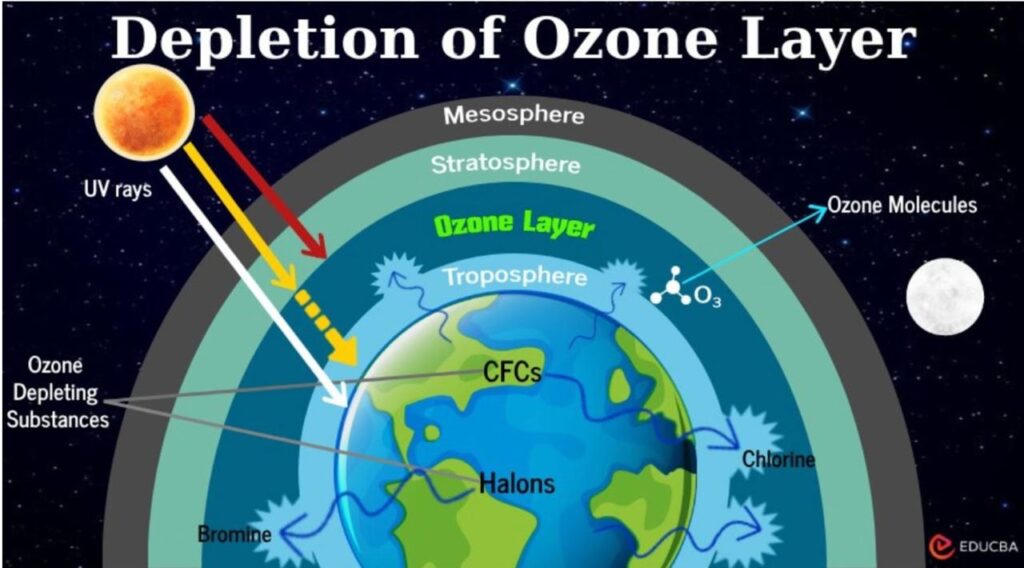
Ultraviolet (UV) Rays
- UV rays are a type of electromagnetic radiation emitted by the Sun.
- Their wavelength ranges from 100 to 400 nm.
- UV Rays 3 Types
- UV-A: 315-400 nm
- UV-B: 200-315 nm
- UV-C: 100-280 nm The most harmful rays but absorbed by the ozone layer
- Stratospheric ozone is called “Good Ozone” because it absorbs 95% of harmful UV rays, protecting life on Earth.
- Hence, it is also known as “Earth’s Protective Shield” or “Earth’s Umbrella.”
Ozone Formation:
- Ozone (O₃) is formed when oxygen molecules (O₂) absorb UV radiation and break into oxygen atoms (O), which then combine with O₂ to form ozone (O₃).
O₂ + UV → 2O
O + O₂ → O₃
Causes of Ozone Layer Depletion
- Halogenated gases are the primary culprits behind ozone depletion. These include: Chlorofluorocarbons, chlorine, bromine, methyl chloroform, carbon tetrachloride etc.
- One chlorine atom can destroy 100,000 ozone molecules.
- Chlorine atoms are released from CFCs due to UV radiation in the stratosphere.
- Increased CFCs and Halons accelerate ozone depletion.
- Chlorine and bromine atoms break ozone molecules through multiple chemical reactions.
- This leads to the thinning of the ozone layer, known as the Ozone Hole.
| CFCl₃ is affected by the sun’s ultraviolet rays (UV rays).The ultraviolet rays break the bonds present in the CFCl₃ molecule.As a result, a chlorine free radical (Cl•) and a CFCl₂ molecule are produced from CFCl₃.CFCl₃+hv→CFCl₂+Cl•The simplest example of such a cycle involves a chlorine atom reacting with an ozone molecule, taking one of its oxygen atoms to form CIO and releasing an oxygen molecule. Chlorine monoxide (CIO) reacts with another ozone molecule (O3) to form another chlorine atom and two oxygen molecules.Cl•+O₃→ClO•+O₂ClO•+O₃→Cl•+2O₂ |
Unit and Measurement of Ozone
- Atmospheric ozone is measured using a Dobson Spectrophotometer and is expressed in Dobson Units (DU).
- One Dobson Unit (DU) equals a 0.01 mm thick layer of pure ozone at standard temperature and pressure.
Atmospheric ozone is measured by –
- Dobson Spectrometer
- Filter Ozone Meter
- Ozone Mapping Spectrometer
Ozone hole
- The ozone hole is not a literal hole with no ozone but rather a region of significant ozone depletion in the stratosphere over Antarctica during the Southern Hemisphere’s spring (August-October).
- The average ozone concentration in the atmosphere is about 300 Dobson Units (DU).
- Any region where ozone concentration drops below 220 DU is considered part of the ozone hole.
- The ozone hole over Antarctica was first identified in 1985 by the British Antarctic Survey team led by Joseph Farman.
The reason for maximum ozone depletion over Antarctica
- Polar Vortex Effect: A large cyclone-like air circulation pattern around the poles. The temperature in the polar vortex drops to -80°C, leading to the formation of Polar Stratospheric Clouds (PSCs), which store ozone-depleting chlorine compounds.
- Polar Stratospheric Clouds (PSCs): Also called “Mother of Pearl Clouds”. Form in polar stratospheric regions and block sunlight, slowing down ozone formation.Contain nitric acid and sulfuric acid, which play a role in ozone depletion. More common in the Southern Hemisphere due to a stronger polar vortex.
- Effect of Active Chlorine: Due to atmospheric circulation, ozone-depleting gases accumulate in the cold polar vortex. These cold conditions trigger chemical reactions, releasing active chlorine, which accelerates ozone depletion.
List of Ozone Depleting Substances
- CFCs (Chlorofluorocarbons)
- HCFCs (Hydrochlorofluorocarbons)
- Halon
- HBFCs (Hydrobromofluorocarbons)
- CCI4 (Carbon Tetrachloride)
- CH3CCI3 (Methyl Chloroform)
- CH3Br (Methyl Bromide)
- CH2BrCL (Bromochloromethane)
- NOx (Nitrogen Oxide)
Ozone depleting potential and global warming potential of various ozone depleting substances
|
Substance |
Experiement/use |
Ozone Depleting Potential (DU) |
global warming potential |
|
Chlorofluorocarbons(CFC) |
Used as a bleaching agent in the manufacture of refrigerants, cleaning solvents, aerosol propellants and plastic foams |
6-10 |
4,680-10,720 |
|
Halons |
Use in fire fighting and explosive safety |
3-10 |
1,620-7,030 |
|
carbon tetrachloride(CCI4) |
Used in production of CFCs, solvents, fire extinguishers |
1.1 |
1,380 |
|
methyl chloroform(CH3CCI3) |
Used as an industrial solvent for cleaning, in inks |
0.1 |
144 |
|
methyl bromide(CH3Br) |
Use in pesticides and crop disease prevention |
0.6 |
5 |
|
Hydrochlorofluorocarbons (HCFC) |
Used in refrigerants for CFC displacement, solvent, in plastic foam manufacturing, as bleaching agent |
0.001-0.5 |
76-2,270 |
|
Hydrofluorocarbons (HFC) |
Used as CFC replacement in refrigerants, aerosol propellants, fire extinguishers |
0 |
122-14,130 |
Effects of Ozone Layer Depletion
- Increased Exposure to UV Radiation: Leads to skin diseases, cancer, sunburn, cataracts, premature aging, and weakened immunity.
- Impact on Marine Ecosystems: UV radiation damages phytoplankton, affecting the entire marine food chain.
- Negative Effect on Photosynthesis: Reduces plant growth and agricultural productivity.
- Decline in Crop Yield and Quality: Certain crops are highly sensitive to UV exposure, leading to lower production.
- Weakened Immune System: Increased UV exposure reduces disease resistance in humans and animals.
- Temperature Increase in Equatorial Regions: Causes extreme heat, which affects physical and mental development.
Ozone chronology
- 1930: Chapman Cycle discovery (explaining ozone formation & depletion).
- 1970: British Antarctic Survey predicts ozone layer depletion.
- 1974: Role of CFCs in ozone depletion identified.
- 1985: Joseph Farman’s team provides direct evidence of ozone depletion over Antarctica.
Efforts to save the ozone layer
Vienna Convention
- Came into effect in 1988.
- Objective: Protection of the ozone layer and reduction in CFC use.
- Non-binding agreement.
- First international treaty with a universal verification system.
Toronto World Conference – (1988) – Canada
- Called for a 20% reduction in CFC usage by 2005 to tackle global warming and ozone depletion.
Helsinki Conference-1989
- Held on May 2, 1989, to accelerate efforts to reduce CFC use.
- March 2, 1990: A seminar on “Ozone Layer Protection” was held in London.
Montreal Agreement –
- Adopted on September 16, 1987 (celebrated as World Ozone Day).
- Came into effect in 1989.
- India signed the protocol in 1992.
- Binding agreement on reducing ODS emissions.
- 197 countries signed the protocol.
- UNEP played a key role in implementation.
- Developed countries were required to completely phase out CFC production & usage by 2000.
- Developing countries were given time until 2010 to stop CFC production & consumption.
- Since 2010, the focus has shifted to phasing out HCFCs (Hydrochlorofluorocarbons).
Kigali Agreement
- Objective: Reduce emissions of HFCs (Hydrofluorocarbons), which contribute to global warming.
- Target: Reduce global warming by 0.5°C by 2100.
- Legally binding from 2019.
- All 197 signatory countries of the Montreal Protocol agreed to phase out HFCs by 2047.
- Developed countries began reducing HFCs from 2019, China from 2024, and India from 2028.
- Goals for India
- August (2021) India’s decision to ratify the Kigali Agreement on the phase-out of hydrofluorocarbons (HFCs).
- India must stabilize the use of HFCs from 2028 and reduce it by 80% from 2025 levels by 2047.
- India’s timetable for reducing HFCs use is as follows –
- 2028: Stabilise the use of HFCs.
- 2032: 10% reduction from 2025 levels.
- 2037: 20% reduction from 2025 levels.
- 2042: 30% reduction from 2025 levels.
- 2047: 80% reduction from 2025 levels.
Note-
- Carbon Tetrachloride (CCI₄), a harmful ozone-depleting chemical, is used by steel manufacturing units.
- UNDP is assisting India in phasing out HCFCs by 2030, showing India’s commitment to the Montreal Protocol.
Pollution
Meaning and definition of pollution
- Pollution which is originally derived from the Latin word Pollutus which means to make unclean.
- According to E.P. Odum: “An undesirable change in the physical, chemical, or biological properties of air, water, and soil that harms humans as well as the natural and cultural elements of the entire environment is called pollution.”
- General Definition: “Harmful and undesirable changes in the quantity or quality of environmental components are called pollution.”
- Pollutants: “Undesirable substances that alter or pollute any fundamental element of the environment are called pollutants.”
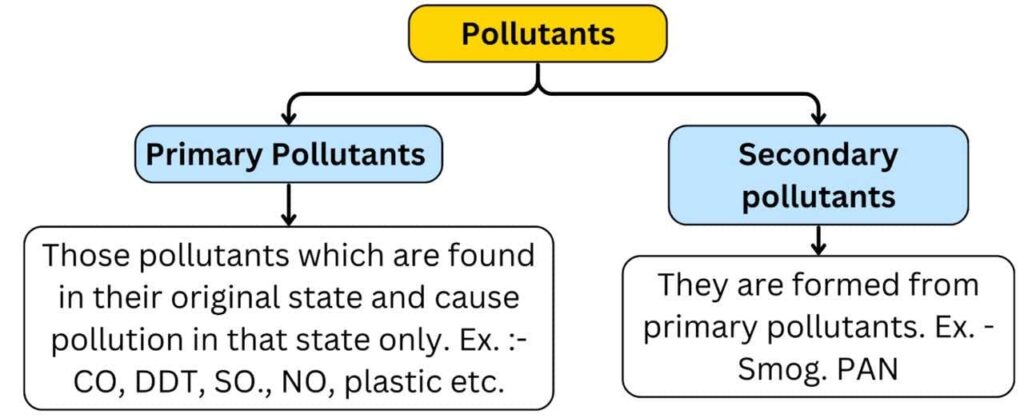
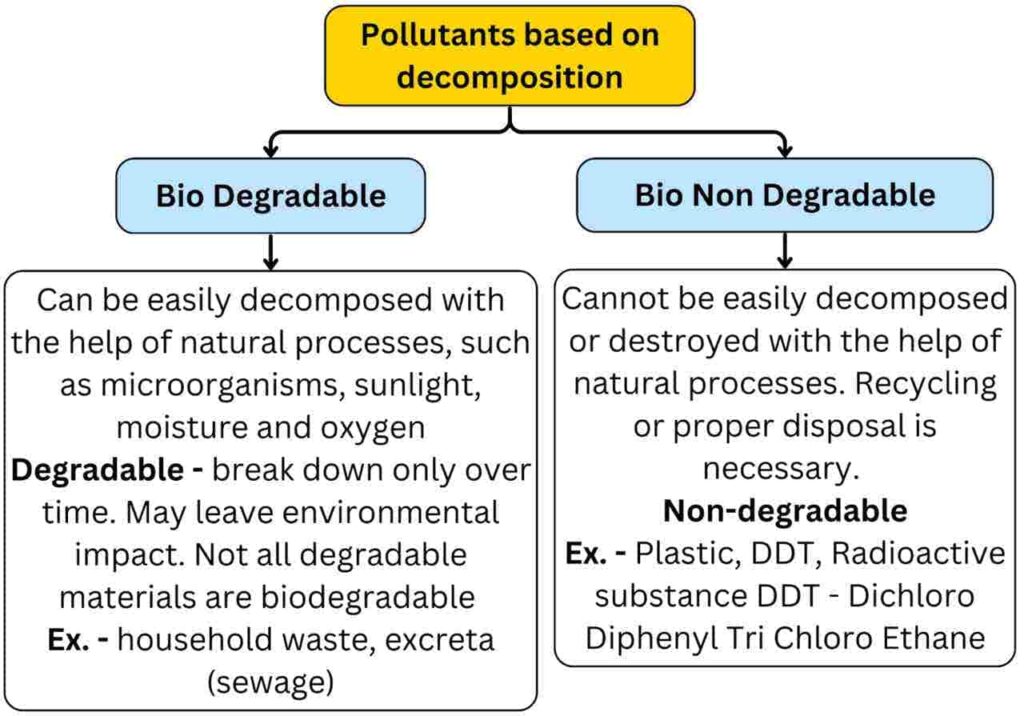
Types of pollution based on the nature of pollutants – (i) Air pollution, (ii) Water pollution, (iii) Noise pollution, (iv) Soil pollution (Land pollution), (v) Vehicular pollution, (vi) Radioactive pollution, (vii) Thermal pollution, (viii) Industrial pollution, (ix) Pollution due to garbage, (x) Marine pollution, (xi) Pollution due to domestic waste, (xii) Pollution due to other causes.
Air Pollution
All the gases present in the atmosphere are found in a fixed ratio such as nitrogen, 78.08 percent, oxygen 20.94 percent, argon 0.93 percent, carbon dioxide 0.04 percent and others 0.02 percent. Even a slight change in this ratio affects the entire system of the atmosphere.
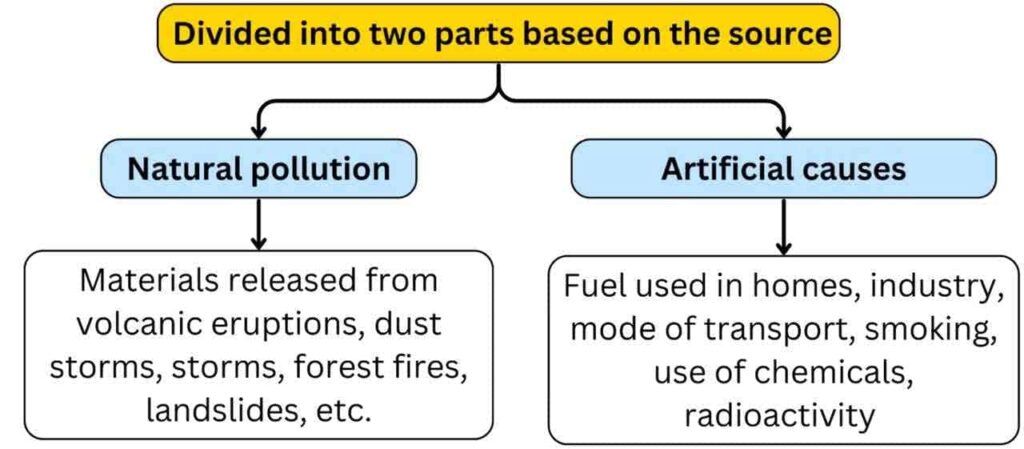

|
Carbon Monoxide (CO) |
|
|
Carbon Dioxide (CO₂) |
|
|
Methane (CH₄) |
|
|
Sulfur Dioxide (SO₂) |
|
|
Chloro Fluoro Carbon (CFC) |
|
|
Nitrous Oxide (N₂O) |
|
|
Nitrogen dioxide (NO₂) |
|
Suspended Particulate Matter:
- Particles whose size is larger than 1000 nanometers and which form suspensions.
- PM 10: Particles smaller than 10 micrometers.
- PM 2.5: Particles smaller than 2.5 micrometers.
- SAFAR–AIR (System for Air Quality Weather Forecasting and Research):
- Mobile app launched in 2015, which measures the air quality of an area.
Problems caused by air pollution:
- Smoking – Emphysema: This disease is caused by smoking too many cigarettes, which reduces the capacity of the lungs.
- Pneumoconiosis: A disease caused by exposure to dust particles.
- Brown Lung: Due to cotton dust, also known as Byssinosis.
- White Lung: Disease caused by asbestos dust.
- Black Lung: This disease occurs in people working in coal mines.
Harmful effects of air pollution
- Adversely affects human health.
- Negatively impacts vegetation. It has become a threat to the existence of animals and insects.
- Adversely affects climate and atmospheric conditions, leading to climate change, ozone layer depletion, greenhouse effect, and weather disturbances.
- Forms smog domes over metropolitan and urban areas.
Air Pollution Control Act:
- Passed: 29 March 1981
- Commenced: 16 May 1981
- initially focused on air pollution, but was amended in 1987 to include noise pollution, which was later separated in 2000 with the enactment of the Noise Pollution (Regulation and Control) Rules.
Measures to control air pollution
A multi-dimensional policy must be adopted for air pollution control. This includes controlling past environmental damage and preventing future pollution through the development and use of new technologies.
- Afforestation should be promoted to prevent pollution, with at least 33% of the land area covered by forests. Green belts should be developed near villages and cities.
- Vehicle pollution should be controlled. Solar energy, battery-operated vehicles, and electric engines (railways) should be used instead of petrol and diesel.
- Smokeless stoves should be used. Trees should not be cut.
- Industries such as brick kilns and pottery-making should be established outside cities.
- Industries should adopt new technologies and be located away from cities.
The Indian government has taken several steps to curb air pollution. Here are some of these steps:
- Air (Prevention and Control of Pollution) Act, 1981.
- The Central Pollution Control Board (CPCB) took up work related to air quality.
- National Air Monitoring Programme (NAMP) established.
- Regulations were placed on industries to meet air quality standards.
- National Clean Air Programme (NCAP) launched – January 2019 – Targets 20-30% reduction in particulate matter (PM) concentrations in 131 cities across 24 States/UTs by 2024. Target revised to 40 % reduction in PM10 levels or achieving national standards (60 μg/m3) by 2025-26.
- National Air Quality Index launched.
- Use of clean and alternative fuels increased.
- Ethanol blending promoted.
- Jump from BS-IV to BS-VI fuel standards. From April 2020, BS-VI compliant vehicles were introduced across the country.
Note – BS standards are Indian pollution control standards, based on European emission standards (Euro Standards) . Objective: To gradually control vehicle emissions in a phased manner.
- Construction and Demolition Waste Management Rules were formulated.
- Graded Response Action Plan (GRAP) notification for Delhi and the National Capital Region (NCR).
Water pollution
Undesirable changes in the physical, chemical and biological characteristics of water which have an adverse effect on humans and all living beings are called water pollution.
Sources of Water Pollution:
- Domestic sewage: Water released from a sewage line.
- Industrial waste: Chemicals and solid wastes released from industries.
There are 5 main parameters of ambient water quality –
- SDG Indicator 6.3.2 It monitors the proportion of water bodies with good ambient water quality concerning national and/or sub-national water quality standards.
- The five water quality parameters are:
- Dissolved Oxygen (Surface Water)
- Electrical Conductivity (Surface Water and Groundwater)
- Nitrogen/Nitrate (Surface Water and Groundwater)
- Phosphorus (Surface Water)
- pH (Surface Water and Groundwater)
Identification of polluted water:
- DO (Dissolved Oxygen): The amount of oxygen dissolved in a liter of water
- Less than 8 mg/L – polluted water.
- Less than 4 mg/L – highly polluted water.
- BOD (biological oxygen demand):
The amount of oxygen required by microorganisms to decompose organic matter in water.- High levels of BOD indicate water pollution.
- COD (Chemical Oxygen Demand) – Chemical Oxygen Demand:
- This is a key method for measuring water pollution.
- It indicates the amount of oxygen required for the complete oxidation of dissolved chemicals in water.
- If COD (Chemical Oxygen Demand) is high, the water is considered polluted.
- MPN (Most Probable Number):
- In this method the number of E. coli bacteria is measured.
Bio – Magnification
- The amount of non-degradable pollutants in a water body increases with trophic levels, i.e., as pollutants move from one organism to another in a food chain.
Eutrophication –
- The word eutrophication is derived from the Greek word ‘eutrophos’ which means nourishment or enrichment. In the context of the environment, enriching a water body with nutrients is called eutrophication. In the process of eutrophication, plants and algae grow in the water body. Apart from this, the amount of oxygen in the water decreases due to the presence of biomass in the water.
Problems caused by water pollution:
- Excess of Mercury (Hg): Minamata disease: Numbness of limbs, lips, tongue, deafness.
- Excess of Cadmium (Cd): Itai-Itai disease: affects liver and lungs.
- Excess of Arsenic [As] – Black foot disease in animals.
- Excess of Fluoride: Fluorosis: Yellow and weak teeth.
- Excess of Lead (Pb): Pulmonism: affects nervous system.
- Excess copper (Cu): Wilson’s Disease: affects liver and brain.
- Excess iron (Fe): Siderosis: deposition of iron dust in lungs.
- Iron deficiency – Anaemia.
- Excess nitrate: Methemoglobinemia (Blue Baby Syndrome): Hole in the heart and lack of oxygen in children.
According to a UNO report, 2300 people are dying every day in the world due to lack of pure water and diarrhea. In the last 30 to 40 years, 40 percent of marine life has decreased due to pollution of sea water.
For example, in India, water used in tanning leather in Kanpur city is released into the Yamuna river. As a result, the water of Yamuna river is no longer fit for use in daily life.
World Water Quality Alliance (WWQA)
- The Joint Research Centre (JRC) of the United Nations Environment Programme (UNEP) and the European Commission launched in Ispra, Italy.
Measures to prevent water pollution
- Sewage treatment plants should be established in all cities for wastewater disposal.
- Organic farming should be promoted instead of chemical-based agriculture.
- Industrial wastewater should be treated and reused.
- Complete ban on disposing of dead animal carcasses in rivers; electric crematoriums should be established.
Noise Pollution
- Noise pollution occurs when the intensity and frequency of sound exceeds the audible level, causing discomfort and disturbance to humans.
- This problem has become serious due to rapidly increasing industrialization, urbanization and means of transportation.
- Noise pollution is measured in terms of its intensity and frequency, and its common unit is decibel (dB).
- Sounds exceeding 80-120 decibels fall under noise pollution.
Causes of noise pollution – from means of transport, speakers, noise emitted from industries, airplanes and jet planes.
Harms due to noise pollution – It has an adverse effect on the human brain. This causes irritability, deafness in humans, extremely loud noise causes permanent loss of hearing power of the person due to which the person starts behaving like a mad person.
Land pollution
The decline in the quality of soil due to natural and human activities is called land (soil) pollution. Soil pollution reduces the fertility of the land. It has a bad effect on the organisms living on the entire globe.
Major causes of land pollution:
- Excessive use of chemical fertilizers: Due to the overuse of chemical fertilizers in Punjab, soil pollution has become a major issue.
- Disposal of industrial waste.
- Accumulation of waste generated from cities and metropolitan areas.
Disadvantages of Soil Pollution:
- Reduction in arable land.
- Major diseases: Dysentery, diarrhea, cholera, eye infections, tuberculosis.
- Emergence of other environmental pollutants.
- Increasing problem of land degradation.
Acid Rain
Acid Rain Definitions and Key facts
Acid rain occurs when gases released from industries, such as carbon dioxide (CO₂), sulfur dioxide (SO₂), and nitrogen oxides (NO₂), react with atmospheric moisture and rainwater, forming acidic compounds.
Key Facts:
- 60-90% of acidity in the atmosphere is due to H₂SO₄ (sulfuric acid), and 30-40% is due to HNO₃ (nitric acid).
- Chemical reactions:
- SO₂ + H₂O → H₂SO₄ (Sulfuric Acid)
- NO₂ + H₂O → HNO₃ (nitric acid)
- The pH of acid rain ranges from 5 to 2.5, which is lower than the neutral pH 7, indicating high acidity.
- In this process, the hydrogen ion (H⁺) concentration increases.
Note- Normal rain has a pH of around 5.6. Acid rain generally has a pH between 4.2 and 4.4 (US EPA, 2019).
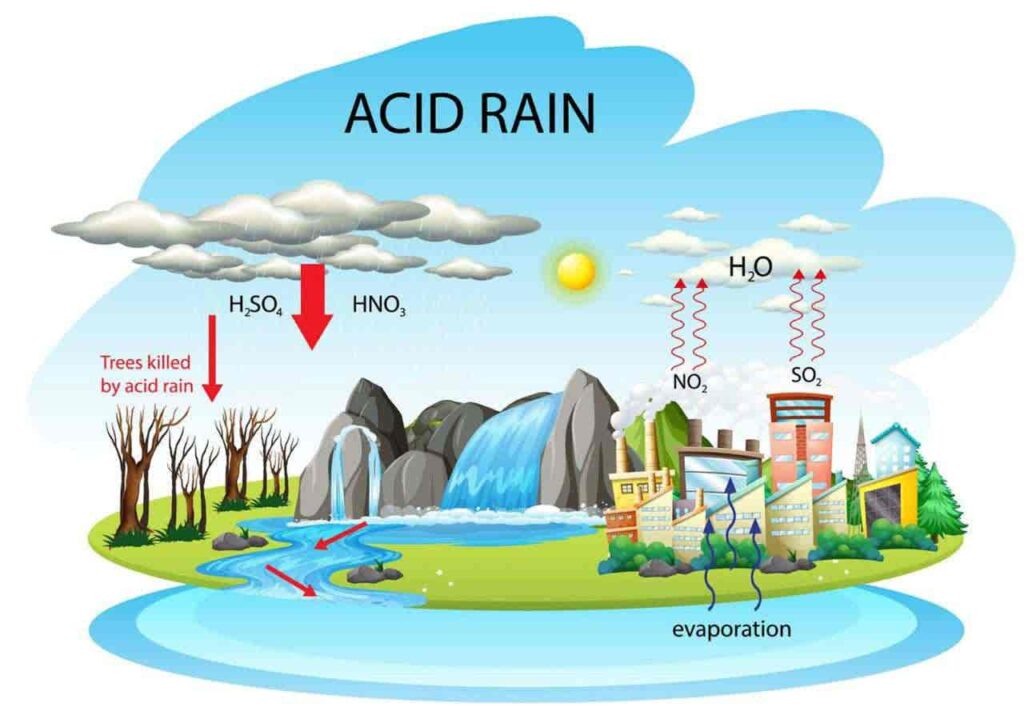
Causes of Acid Rain
- The main causes of acid rain are NO₂, SO₂, NO, and CO.
- SO₂ undergoes chemical reactions to form H₂SO₄.
- Major Sources of SO₂:
- Automobiles, coal, and thermal power plants.
- Thermal power stations where coal is burned in large quantities for electricity generation.
- Petroleum refining industries.
- Motor vehicles.
- Burning of fossil fuels.
Effects of Acid Rain:
- Decline in Soil Productivity: High acidity leads to the depletion of minerals and nutrients in the soil.
- Affected Areas: Acid rain can spread over long distances, affecting regions far from industrial and transportation sources.
- Contamination of Drinking Water: Acid rain increases toxic substances and bacteria in water sources, leading to health problems.
- Impact on Forests: Acid rain forms a waxy layer on leaves, affecting photosynthesis and biological processes. About 8% of forests have been destroyed due to acid rain.
- Effect on Water Bodies: Lakes and rivers become more acidic, harming aquatic life and vegetation.
- Increased Soil Acidity: Acid rain damages plants and microorganisms, slowing down biological processes.
- Damage to Buildings: Acid rain causes corrosion of marble and stone structures, affecting monuments like the Taj Mahal and European sculptures.
Possible solutions:
- Control of SO₂ and NO₂: Industries should use scrubbers, bag filters, and colloidal tanks to reduce emissions.
- Renewable Energy: Promotion of solar and wind energy to minimize fossil fuel usage.
- Reduced Vehicle Usage: Limit the number of personal vehicles and ensure regular pollution checks.
- Water and Soil Treatment: Lime (CaCO₃) should be added to acidic water sources and soil to neutralize acidity.
- Industrial Regulations: Effective prevention of harmful gas concentration from increasing industrial activities.
Global conventions and efforts to tackle acid rain
- Convention on Long-Range Transboundary Air Pollution (LRTAP) – 1979
- Organized under the United Nations Economic Commission for Europe (UNECE), this is an umbrella agreement for air pollution control among member countries.
- Eight protocols have been developed under this convention to identify specific measures for reducing emissions of air pollutants.
- US-Canada Air Quality Agreement (1986) and Ozone Annex (2000) – These agreements are crucial for acid rain control and commit both countries to reduce nitrogen oxides (NOₓ) and volatile organic compounds (VOCs), which contribute to ozone formation.
Environmental Issues / Environmental Issues / Environmental Issues / Environmental Issues / Environmental Issues / Environmental Issues / Environmental Issues / Environmental Issues / Environmental Issues / Environmental Issues / Environmental Issues / Environmental Issues / Environmental Issues / Environmental Issues / Environmental Issues / Environmental Issues / Environmental Issues / Environmental Issues / Environmental Issues / Environmental Issues / Environmental Issues / Environmental Issues / Environmental Issues / Environmental Issues / Environmental Issues / / Environmental Issues / Environmental Issues / Environmental Issues / Environmental Issues / Environmental Issues / Environmental Issues / Environmental Issues / Environmental Issues / Environmental Issues / Environmental Issues / Environmental Issues / Environmental Issues / Environmental Issues / Environmental Issues / Environmental Issues / Environmental Issues / Environmental Issues
